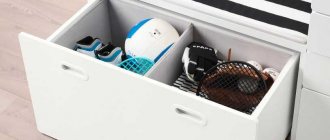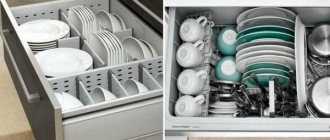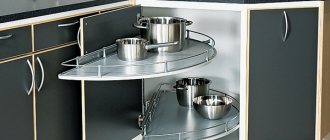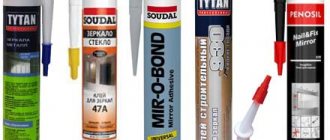Parsing and sorting
Step one is to take absolutely everything out of your wardrobe. This will make it easier to decide which ones are needed and which ones are not. Go through the items of clothing one at a time, putting them in different directions depending on your decision: to keep, give away or sell, throw away.
When your next dress or T-shirt is in doubt, ask yourself supporting questions.
- “Have I worn this for the last year?” If the item was in the closet, then, most likely, it can continue to lie there idle for more than one month or even a year. It's better to free up space rather than storing things you don't need in your wardrobe.
- “Would I buy this item now?” Imagine that on your last trip your luggage and a good half of your wardrobe were lost and now you need to put it together again. Would you buy what you hold in your hands to replace what you lost? If the answer is a clear “yes,” then the item should be kept.
- “Does it need a replacement?” Assess the condition of the item you took. If there are stains, pills, snags and other signs of wear on it, then it is better to replace it with a new and fresh one.
When you're done with sorting, start by focusing on the things you decided not to keep. Place unwearable items in the trash pile. Items that are wearable, but have lost your liking, can be given away. Or sell it so it doesn’t go to waste. And put what should go back into the wardrobe into piles: tops, trousers, skirts, underwear, socks. This will help you compare the volume of clothes you have with the capacity of your closet.
Getting rid of unnecessary things
Once your wardrobe has been sorted into seasonal piles, it’s time to take a closer look at them and divide them into several categories:
- good things that are worn all the time;
- stretched, out of shape or damaged;
- decent clothes that you don’t wear for some reason.
Everything is clear with the first category. These clothes must be inspected if you need to send some of them for washing, and put the rest in the closet.
If an item has lost its original appearance: the sweater is all in pills, the knees are stretched out on the trousers, it should be put in a heap to be thrown away. You should also send faded or torn clothes there. You can safely take this pile to the trash heap and not regret it, since these things will not be able to decorate you either at home, or on a hike, or at the dacha.
The last category is what you don't wear. Perhaps the clothes became small or there was nothing to wear them with, or they were bought at a huge discount, but were not useful. We also need to get rid of this. Determine a period, for example a year, to cover the entire season, and feel free to throw out those that have not been worn during this time. Items of good quality, but not the right size, can be given to a friend or acquaintance. If it’s a pity to throw them away, you can give them to charity: take them to church or volunteers. They will find use there.
Clothes that are out of fashion should also not be left in the closet under the pretext that “fashion is coming back.” Cyclicity does exist, but only the general direction is preserved. And things, after lying around for several decades, can turn yellow and deteriorate.
Related article: Substrate for water-heated floors
If after these manipulations there are still too many things, try to sort them according to “need”. Look carefully, perhaps you have 3 shirts of the same color or a pair of identical jumpers? Then you should keep what fits better with the rest of your wardrobe and get rid of others.
We do the same with shoes. When your favorite boots have faded, you can paint them. However, if they have lost their shape or are badly torn, it is better to throw them away and buy new ones.
Important! You should get rid of the habit of moving unnecessary things from one place to another. For a dacha or vegetable garden it can be useful during repairs, you need to forget about it once and for all. Even in the garden you should not look like a scarecrow.
Organization of space
Even the most modest-sized wardrobe can be expanded and deepened if desired.
- Engage doors and walls . Hanging organizers with sections and pockets can be attached to cabinet doors from the inside. Another option is to add several hooks to leave things on them that need to be at hand. On them, so as not to get lost, you can hang scarves, shawls, belts and other small items.
- Use the “matryoshka principle” . Suitcases and bags stored in the wardrobe will help save space: you can put some things (for example, the same seasonal clothes) from the shelves inside.
- Add a second rod . Tall cabinets often leave a lot of free space above or below the hanging rod. Use it: the second beam will allow you to hang even more things. Space on the shelves will be freed up.
- Buy special hangers . You can hang two or three shirts at once on one regular shirt. And you can find ultra-thin hangers that can easily fit on a bar of any length. Another option is multi-tiered hangers with covers that are ready to take several suits on their hangers at once.
How to save space in your closet
If your closet is small and you have a lot of clothes, then get creative in storing things. There is no need to squeeze the clothes too much. Better use every corner of the closet that you have at your disposal. Some girls, for example, use the back of a closet door to hang their socks, belts, and jewelry on hooks or in organizers.
Another way to save space in your closet is with multifunctional hangers, on which you can store several sets of clothes at once. Whether it's jeans or blouses, organizing your clothes with multi-functional hangers creates extra closet space. It's important to choose non-slip clothing hangers to prevent silk or satin items from falling off and creating a tangled pile at the bottom of your closet. This will definitely disrupt his entire organization.
Storing clothes in drawers
A very unusual, but at the same time effective way to store T-shirts or jeans in a drawer is a vertical arrangement. To do this, you should not stack things on top of each other, but you should put them in a row, one in front of the other. This way, when you take out an item, you will easily find it and you won’t have to lift the entire stack, making a mess.
We recommend that you lay out your underwear, scarves and socks using the same pattern. To divide clothes into sections in drawers, use clothing dividers.
If there is no space left on the hanger and in the drawer, then, of course, you can fold the clothes horizontally on top of each other. But even in this case, you can use thin dividers to quickly find the item you need and not disturb the order in your wardrobe.
How to store shoes and bags
There are several ways to store shoes in a practical way. The first is the easiest and does not require any boxes or drawers. Just arrange your shoes neatly at the bottom of the closet. So, you will always see what you have. And you can quickly select the right shoes to match your clothes. The next storage method is a hanging case. It can be attached to a handrail in a closet if there is space. Another way is a separate shelf for shoes with drawers or dividers. It is very important to store shoes in wide boxes that will not squeeze them.
As for bags, in this case, you can put them on shelves with dividers, or simply hang them on hooks. Before putting the bag in the closet, fill it with any lightweight material so that it does not lose its shape and does not leave wrinkles.
How to store accessories in a closet
Accessories such as belts, scarves and ties can be stored in drawers using vertical layouts and dividers. In addition, scarves and ties can be hung on special multifunctional hangers to save space.
Selection criteria
Order in the closet is required so that it is always easy to find the right thing. You should not create a landfill by throwing clothes inside at random. Let your wardrobe be functional. Therefore, before returning things that are not destined to be thrown away or given away, decide on what principle they will be arranged.
- By style . Let clothes for work, things for going out on weekends, for parties, for summer holidays, for winter colds be in different piles.
- By appearance . You can sort things differently: all T-shirts are together, as well as jeans, skirts, dresses, blouses, sweaters and other items of clothing.
- By color . Color sorting also has its advantages. When there are stacks of green, blue, white, red things, it becomes easier to combine them with each other.
There is another tip - to divide the space in your wardrobe into several zones. The first should be the most accessible, within an outstretched hand. Put the most popular items there that you wear most often. Let the wardrobe items that are less necessary in everyday life go to the second zone: for example, elegant dresses and blouses. The third zone contains clothes for business meetings: formal shirts, trousers, jackets. Well, the fourth zone - the farthest one - can be filled with things the need for which appears very rarely.
Whichever of the recommendations you choose, there is no doubt: with this order of time, it will take much less time to get ready in the morning.
How to clean using Marie Kondo's method
- Set aside a specific time each day to tidy up. Don't grab everything at once, act gradually, this will allow you to save energy.
- For many housewives, the mere mention of cleaning spoils their mood. In such cases, it is better to turn on music, and if the closet is located in a room with a TV, you can combine business with pleasure and sort things out while watching a movie or talk show.
- Use the “three boxes” principle. In the first, pack the things you don’t need, the second is for seasonal and formal clothes, and in the third, put what you need constantly.
Many people find it difficult to determine which item is needed and what can be thrown away or given away. Everything is clear with damaged clothes and shoes, but what about intact and almost new things that just take up space in the closet?
Marie Kondo suggests sorting your wardrobe according to this principle: determine whether a particular item of clothing or accessory brings you joy or not. In the first case, you can leave the item, but at the same time start using it. Items in the second category go into the junk box.
- When you have sorted out the necessary and unnecessary things, they need to be compactly laid out. Marie Kondo suggests storing clothes by folding them in rectangles, and rolling small wardrobe items into tubes or folding them in half. This will allow you to fit a lot of things in a small space.
- To make it easier to find the things you need, organize them by color. Now you will always know where the right scarf, T-shirt or pair of socks is.
This technique allows you not only to conveniently organize clothes and accessories, but also to fit a lot more things into your closet than you might have imagined.
Saving the result
It’s one thing to restore order, quite another to maintain it. This may be even more difficult. If you follow a couple of helpful tips, you won't need your next cleaning for a long time.
- Keep an empty bag in your wardrobe to put in it clothes that you no longer like or, for example, become outdated. Then you won’t have to waste time trying to find such things in the general mass.
- Hangers should not stick together. In such a situation, some of the hanging things simply will not be visible. Separate the hangers from each other with a one-centimeter indentation.
- By the way, about hangers. Let them always remain in the closet in the same quantity. You can’t add new ones: then you will know that something you buy by chance and often don’t really need will simply have nowhere to hang it.
You can use this universal instruction again when your wardrobe needs a thorough cleaning again. But it’s better to try to keep it in order after the first such analysis - for your own convenience.
Keep your closet organized
Once you've finished organizing your closet space, you'll want to keep your closet organized on an ongoing basis. In order to put your things in their places, you will need literally 10–20 minutes a week.
When buying new things, try to place them so that they do not interfere with the already built storage scheme. Of course, if there is very little space in your closet, then you will have to take out the clothes or shoes that you use the least and put them in the closet or under the bed. This will create space to accommodate the new acquisition.
We hope that after reading this article, you are inspired to completely overhaul your wardrobe. And in the near future you will certainly do this. We believe that everything will work out for you and wish you good luck!
For example…
- A separate pile for duvet covers , a separate one for sheets, a separate one for pillowcases.
- Storing in pillowcases. Each set comes in a pillowcase of its own color. Neat and compact. And most importantly, you don’t have to look for anything.
- Each set is in its own pile, tied with a beautiful wide ribbon . Exquisite and for the lazy.
- Rolls . This option is suitable for both towels and bed linen. Can be stored directly on shelves or in boxes.
- In vacuum bags , if you have a shortage of space. But then don’t forget to divide the laundry according to seasonality (according to the density of the material).
- In boxes/cases of the same style. Large – for duvet covers in rolls. Smaller - for sheets. And the third is for pillowcases.
And don't forget the lavender bags!
Wardrobe mistakes
The following are signs that your wardrobe/clothing closet is not organized correctly:
1. “The closet is full, but there is nothing to wear.”
There are reasons for this problem:
- discrepancy between the wardrobe and real life (for example, you are on maternity leave, and the closet is full of office clothes),
- “scattered” wardrobe, lack of basic things, but a lot of randomly purchased ones,
- clothes that don’t fit (you’ve gained weight or lost weight) - such clothes take up space and create the effect of a “closet full.” Her “finest hour” may never come, and things will become irrelevant.
- worn clothes: a few pills, slightly grayish white color, threads sticking out here and there. If this sounds like you, it’s time to start decluttering!
2. You spend a lot of time (more than 30 minutes) trying to figure out what to wear.
3. On the shelves there are things in several rows, and on hangers - in several layers.
4. You have things that you simply forget about because they are put away far away and simply do not catch your eye (sometimes you even buy duplicates of them - a similar blouse, T-shirt, trousers).
5. You don’t have time to service the cycle of things: you want to “wear something else,” but this thing is in the wash.
6. I don’t want to buy anything, because Why? because there are so many clothes...
It turns out to be a vicious circle. And I really want a working wardrobe, so that everything fits together, there are many sets of clothes, but things don’t take up half the house.
90% of women have some signs of an incorrect and disorganized wardrobe. By and large, to cope with the situation, you need the services of three specialists: a psychologist, a stylist and a space organizer.
But first, here's a short but succinct guide to an organized wardrobe.
Divide your drawer space
Drawers of small depth can be wisely used for storing underwear, hosiery, scarves/ties and all kinds of accessories.
The interior space of the drawers should be divided into sections, each of which will be designed to accommodate one neatly rolled or folded item. For these purposes, use dividers that you can buy or make yourself.
Read other articles on the blog on a similar topic: “5S System: Meaningful Cleaning Based on Kaizen Principles”, “How to Maintain Creative Disorder and Deal with Chronic Clutter”, “Men, Children and Pets: How to Maintain Order and Not Go Crazy”.
React Like Love Haha Wow Sadness Angry
1
How to properly hang things on hangers
To prevent things from losing their appearance, hangers for them should be selected according to size. If the hangers are too long, bubbles will appear on the sleeves; if the hangers are too long, things will slip and wrinkle. When choosing hangers, you also need to take into account the weight of the products:
- For outerwear (fur coats, sheepskin coats, coats) you need voluminous hangers with extended wings that can support weight up to 7 kg. Preference should be given to products made of non-slip plastic or polished wood.
- It is recommended to hang jackets, jackets and suits on anatomical hangers with widened ends and a crossbar with clips.
- Skirts should be stored on hangers with silicone or rubber clothespins.
- Trousers can be hung on the hanger bar, but it must be voluminous so that there is no fold line on the legs. The best option is to purchase special hangers equipped with clips.
- Dresses, blouses, shirts are stored on thin hangers made of plastic, wood or metal.
If there is not enough space on the crossbar, then it is better to refuse foam hangers. Then you will be able to save the missing centimeters and place more things.
Wardrobe cleaning process
Before you begin to properly organize your space, you should “sort out the rubble” by studying what is generally stored in the deep depths of your wardrobe. There are several simple rules for this.
- Working from scratch. Shifting clothes from place to place in a closet packed to the brim makes absolutely no sense. Take everything out of the furniture, sort through it and sort it. Only after this simple fraud do you put all the neat piles back. We guarantee that you will definitely find things that you have already forgotten about.
- Checking clothes for the season. Before putting summer or winter clothes into “standby mode,” inspect them thoroughly. If a button comes off, sew it on, if a stain appears, wash it. Put each item in full combat readiness so that, as soon as necessary, you can take it out of your wardrobe, put it on and go about your business. Agree, it will be a shame when in the first frosts you take out your jacket and its zipper is broken or there is a stain on the sleeve.
- You cannot hang something that is easier to fold or vice versa. Foldable: items decorated with beaded embroidery, cashmere items, wardrobe items made of denim or any delicate fabrics. Hanging: trousers, dresses, shirts, skirts.
- Minimalism in boxes. The downside of storing things in boxes is the creation of a shaky structure that goes far to the ceiling. If seasonal clothing is stored in such containers, then this option is acceptable, but for items of daily use, limit yourself to a couple of boxes. A large number of cardboard boxes will be inconvenient to take out and put back in place.
- Don’t despair if you can’t clean it up once and for all. You need to develop a habit.
- Have a sale. For every new item, there are two old ones that should have been disposed of long ago. Charitable foundations, orphanages, those in need - there are many places where your unnecessary ballast will do more good than lying in the wardrobe.
Organization of storage on shelves
Almost any closet is equipped with shelves. Not all things can be stored on hangers, and sometimes there is no point in doing so. But shelves can turn out to be real enemies rather than helpers if you place clothes on them incorrectly.
Stacks
Some types of clothing, such as T-shirts, sweaters and even jeans, are not hung on hangers, but rather placed on racks. Here's how to organize them correctly:
- Never place two stacks next to each other; this will make the back stack inaccessible.
- When you want to remove clothes from a pile, especially if there is no item on top, remove the entire pile, remove what you need, and return everything to its place. This way your storage stacks will always be perfectly aligned.
It is convenient to store small items, as well as knitted clothes, in stacks
I am the owner of a not very convenient and not very spacious closet. Or rather, the closet is quite large, but storing clothes in it is not very convenient due to the large number of shelves and depth. Yes, storing the clothes you need in two piles one after another is the height of inconvenience. But, having three children, I have to do this due to lack of space. Here's how I got out of the situation. In the summer, I have T-shirts and shorts/skirts in the nearby piles. Behind them in the second row are jeans, sweatpants and long-sleeved sweaters. When another season comes, the piles also change places. There is nothing wrong if, along with T-shirts, there are two long-sleeve sweaters at the bottom of the stack, as well as if jeans are temporarily adjacent to shorts. In the off-season, the weather sometimes surprises. But in general, the method works great, and the space in the closet is not empty.
Vertical
This method is not new, but it is not used so often. Its essence is this: everything that can be placed on an edge must be placed on it. That is, you need to use containers, cases and boxes in which things are arranged vertically. This increases your visibility, you can easily get any thing, unlike the previous method, when you usually take the top things from the stack.
When stored vertically, items take up very little space
The method is incredibly convenient for women's tights. Having an older daughter in high school, I have to stock up on this wardrobe item in double size. I store them in a teapot box; it fits perfectly in width and height. From above I can see the color of the tights, so choosing the right ones is not difficult. And yes, in our family some tights are not disposable, for example, winter, a thickened version. After washing, I wrap them on cardboard, like those that are in new packages of tights. That's why they're just as easy to find in my box.
Rolling into a tube
This method, when things are rolled up, is more often used when packing a suitcase, but is also used for long-term storage. It is convenient to store towels, underwear, and tights in this way.
Things rolled into a tube do not wrinkle and take up little space
This is how I store children's undershirts: they take up less space and don't wrinkle.
Video: folding things using the KonMari method
DRAWERS FOR LINEN, BELTS, SCARFS
A chest of drawers is an excellent solution for storing such items; if there is no chest of drawers, then buy organizer boxes, place them on the shelves of the closet, and put things in them so that you can easily see everything you need.
Storage assistants
Use numerous accessories to optimize storage in your closet. It can be:
- special organizers for use in drawers;
An organizer will help you neatly place your underwear in your closet. - hanging pockets that will not take up much space and will help organize various small items, accessories, jewelry and socks;
- special holders for trousers will keep this wardrobe item in neat condition;
- Different containers with lids provide excellent protection from dust.
These storage aids make it possible to keep things in perfect order.
Storing underwear
After you've sorted out your outerwear, it's time to start organizing the storage of your underwear and socks. It is more convenient to keep them in separate drawers. If your wardrobe is not equipped with these, then you can buy a beautiful box in the store. At the moment, in hardware stores there is a huge selection of such containers of all colors and from any material. Choose those that fit well in your closet and that you like in design.
If you couldn't find boxes to your liking, you can make them yourself. To do this, take a simple cardboard box and cover it with self-adhesive paper, wrapping paper or wallpaper that matches your interior. Linen can be sorted by color, folded and neatly laid out. You can put dividers inside the box. This makes it convenient to store not only socks, underwear, but also neck scarves.











